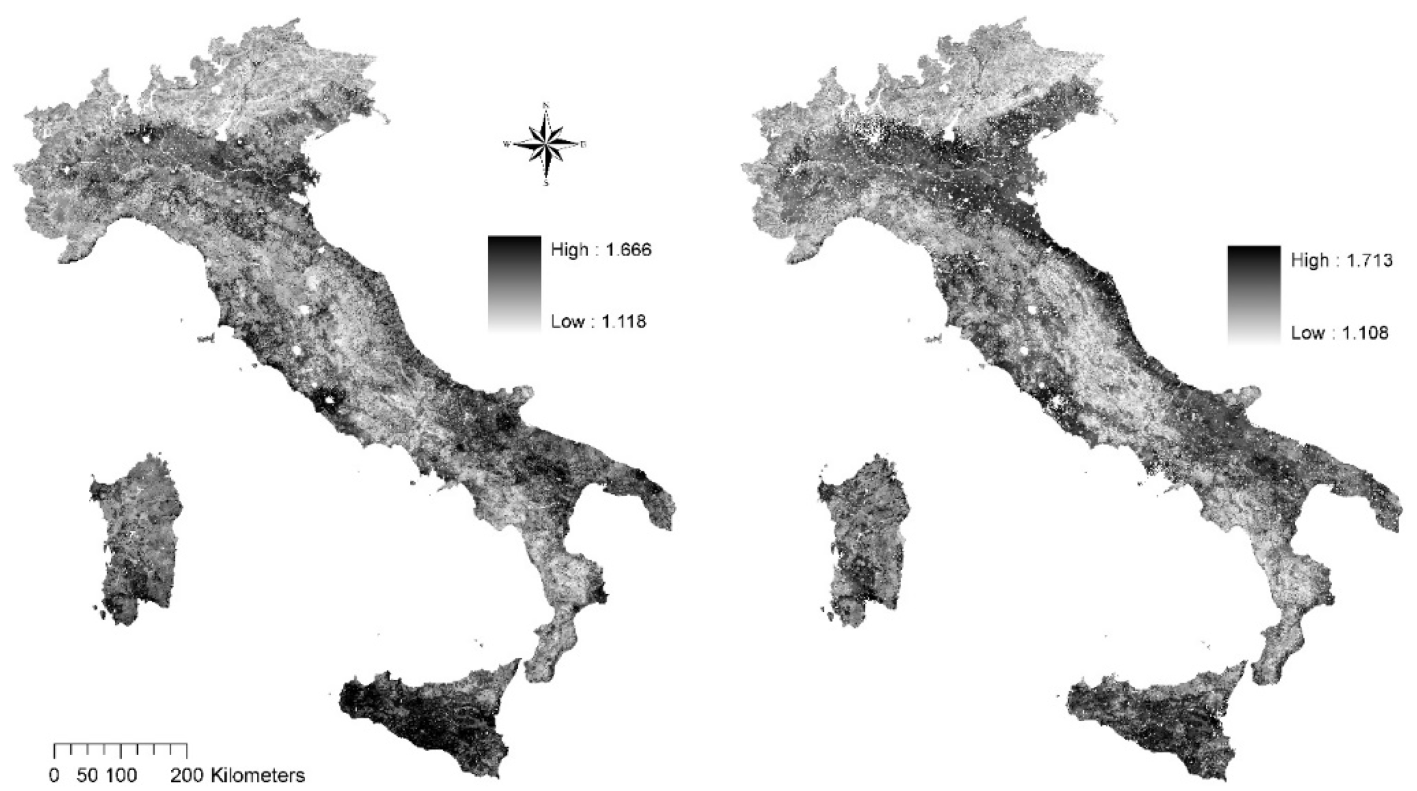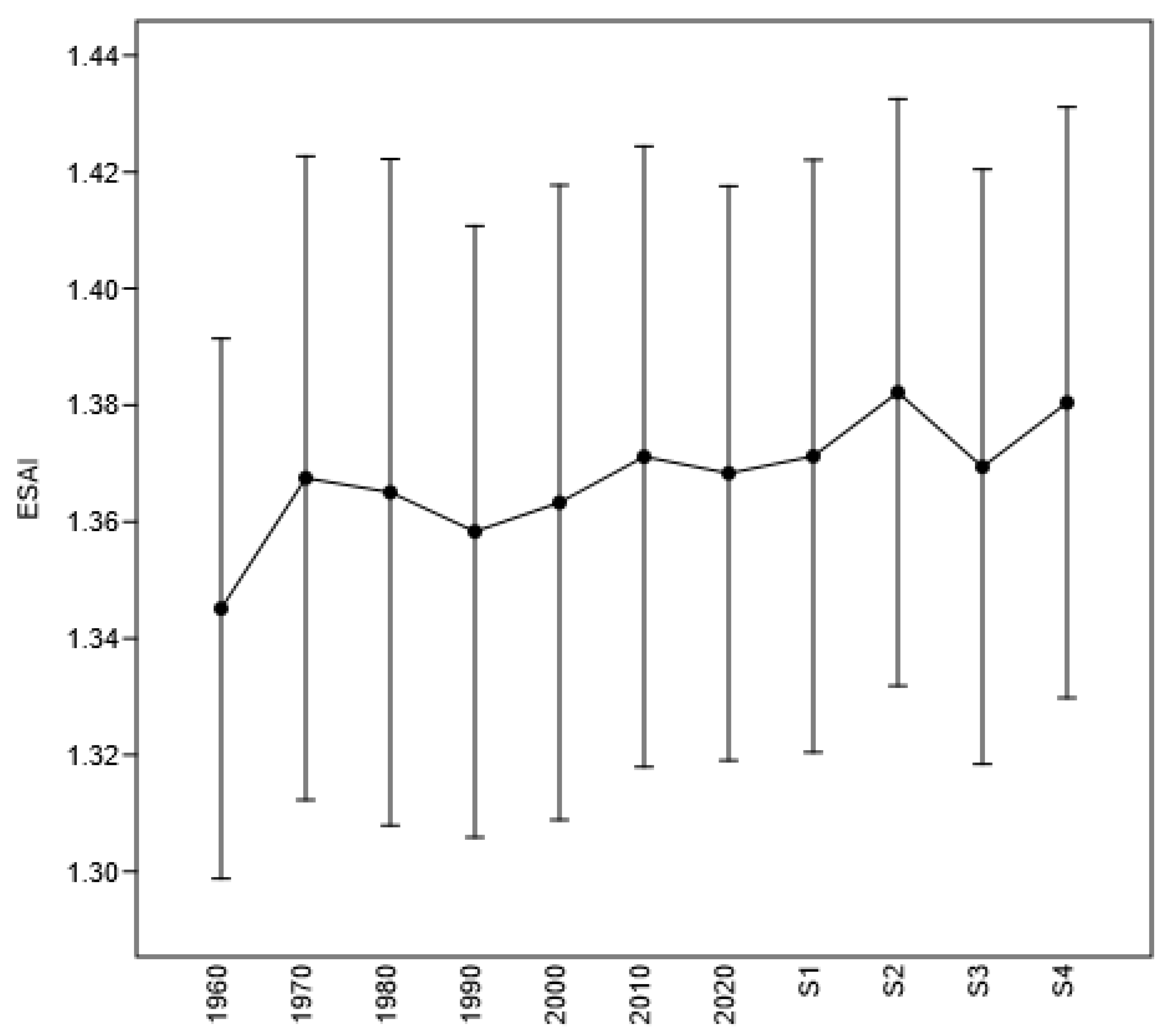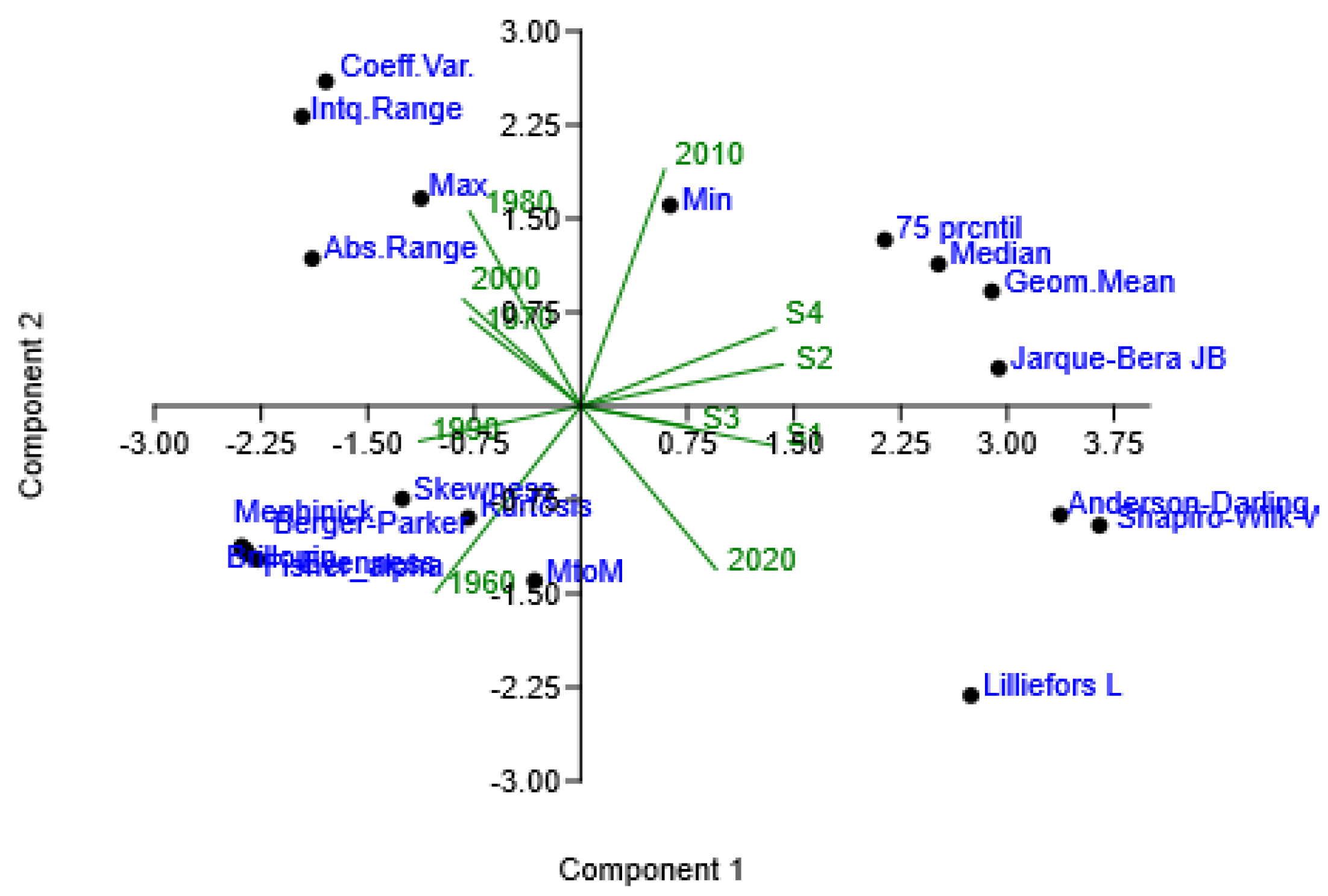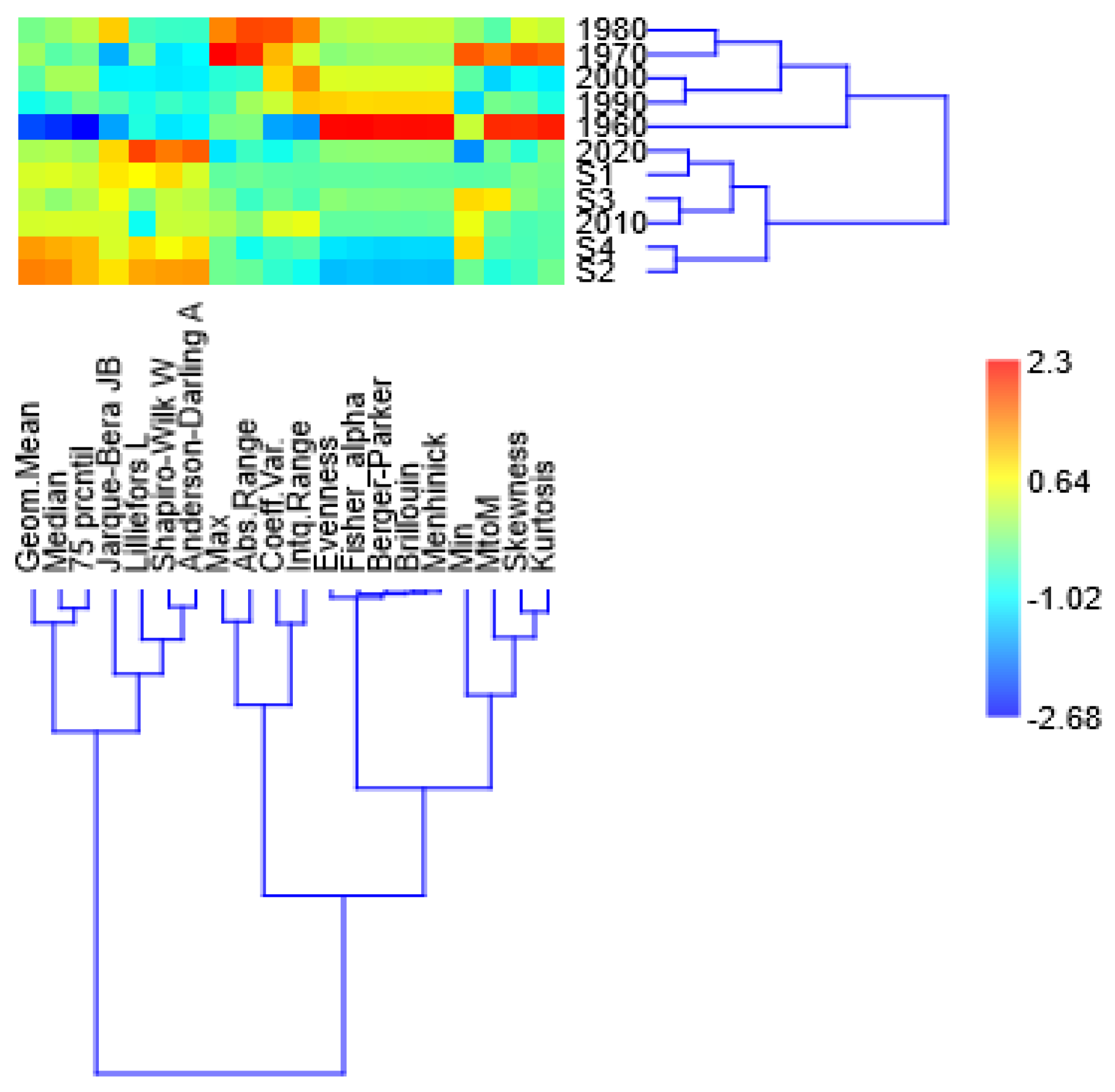Scrutinizing the Statistical Distribution of a Composite Index of Soil Degradation as a Measure of Early Desertification Risk in Advanced Economies
Abstract
1. Introduction
2. Methodology
2.1. Study Area
2.2. Data and Variables
2.3. Indicators and Future Scenarios
2.4. Data Analysis
Multidimensional Analysis
3. Results
3.1. A Descriptive Analysis of a Composite Index of Soil Degradation
3.2. Distributional Metrics Delineating Trends over Time in a Composite Index of Soil Degradation
3.3. A Multivariate Analysis of Distributional Metrics in a Composite Index of Soil Degradation
4. Discussion
5. Conclusions
Author Contributions
Funding
Data Availability Statement
Conflicts of Interest
References
- Abahussain, A.A.; Abdu, A.S.; Al-Zubari, W.K.; El-Deen, N.A.; Abdul-Raheem, M. Desertification in the Arab Region: Analysis of current status and trends. J. Arid Environ. 2002, 51, 521–545. [Google Scholar] [CrossRef]
- Amiraslani, F.; Dragovich, D. Combating desertification in Iran over the last 50 years: An overview of changing approaches. J. Environ. Manag. 2011, 92, 1–13. [Google Scholar] [CrossRef] [PubMed]
- Assennato, F.; Smiraglia, D.; Cavalli, A.; Congedo, L.; Giuliani, C.; Riitano, N.; Strollo, A.; Munafò, M. The Impact of Urbanization on Land: A Biophysical-Based Assessment of Ecosystem Services Loss Supported by Remote Sensed Indicators. Land 2022, 11, 236. [Google Scholar] [CrossRef]
- Martinho, V.J.P.D. European Union farming systems: Insights for a more sustainable land use. Land Degrad. Dev. 2022, 33, 527–544. [Google Scholar] [CrossRef]
- Becerril-Piña, R.; Mastachi-Loza, C.A.; González-Sosa, E.; Díaz-Delgado, C.; Bâ, K.M. Assessing desertification risk in the semi-arid highlands of central Mexico. J. Arid Environ. 2015, 120, 4–13. [Google Scholar] [CrossRef]
- Bestelmeyer, B.T.; Okin, G.S.; Duniway, M.C.; Archer, S.R.; Sayre, N.F.; Williamson, J.C.; Herrick, J.E. Desertification, land use, and the transformation of global drylands. Front. Ecol. Environ. 2015, 13, 28–36. [Google Scholar] [CrossRef]
- Briassoulis, H. Governing desertification in Mediterranean Europe: The challenge of environmental policy integration in multi-level governance contexts. Land Degrad. Dev. 2011, 22, 313–325. [Google Scholar] [CrossRef]
- Bojö, J. The costs of land degradation in Sub-Saharan Africa. Ecol. Econ. 1996, 16, 161–173. [Google Scholar] [CrossRef]
- Davison, C.W.; Rahbek, C.; Morueta-Holme, N. Land-use change and biodiversity: Challenges for assembling evidence on the greatest threat to nature. Glob. Change Biol. 2021, 27, 5414–5429. [Google Scholar] [CrossRef]
- Barbero-Sierra, C.; Marques, M.J.; Ruíz-Pérez, M. The case of urban sprawl in Spain as an active and irreversible driving force for desertification. J. Arid Environ. 2013, 90, 95–102. [Google Scholar] [CrossRef]
- Danfeng, S.; Dawson, R.; Baoguo, L. Agricultural causes of desertification risk in Minqin, China. J. Environ. Manag. 2006, 79, 348–356. [Google Scholar] [CrossRef] [PubMed]
- Van Vliet, J.; de Groot, H.L.; Rietveld, P.; Verburg, P.H. Manifestations and underlying drivers of agricultural land use change in Europe. Landsc. Urban Plan. 2015, 133, 24–36. [Google Scholar] [CrossRef]
- Cecchini, M.; Zambon, I.; Pontrandolfi, A.; Turco, R.; Colantoni, A.; Mavrakis, A.; Salvati, L. Urban sprawl and the ‘olive’ landscape: Sustainable land management for ‘crisis’ cities. GeoJournal 2019, 84, 237–255. [Google Scholar] [CrossRef]
- De Fioravante, P.; Strollo, A.; Cavalli, A.; Cimini, A.; Smiraglia, D.; Assennato, F.; Munafò, M. Ecosystem Mapping and Accounting in Italy Based on Copernicus and National Data through Integration of EAGLE and SEEA-EA Frameworks. Land 2023, 12, 286. [Google Scholar] [CrossRef]
- Ciommi, M.; Chelli, F.; Carlucci, M.; Salvati, L. Urban Growth and Demographic Dynamics in Southern Europe: Toward a New Statistical Approach to Regional Science. Sustainability 2018, 10, 2765. [Google Scholar] [CrossRef]
- Colantoni, A.; Mavrakis, A.; Sorgi, T.; Salvati, L. Towards a ‘polycentric’ landscape? Reconnecting fragments into an integrated network of coastal forests in Rome. Rend. Lincei 2015, 26, 615–624. [Google Scholar] [CrossRef]
- Gomes, E.; Inácio, M.; Bogdzevič, K.; Kalinauskas, M.; Karnauskaitė, D.; Pereira, P. Future land-use changes and its impacts on terrestrial ecosystem services: A review. Sci. Total Environ. 2021, 781, 146716. [Google Scholar] [CrossRef]
- Basso, F.; Bove, E.; Dumontet, S.; Ferrara, A.; Pisante, M.; Quaranta, G.; Taberner, M. Evaluating environmental sensitivity at the basin scale through the use of geographic information systems and remotely sensed data: An example covering the Agri basin (Southern Italy). Catena 2000, 40, 19–35. [Google Scholar] [CrossRef]
- Briassoulis, H. The institutional complexity of environmental policy and planning problems: The example of Mediterranean desertification. J. Environ. Plan. Manag. 2006, 47, 115–135. [Google Scholar] [CrossRef]
- De Groot, R. Function-analysis and valuation as a tool to assess land use conflicts in planning for sustainable, multi-functional landscapes. Landsc. Urban Plan. 2006, 75, 175–186. [Google Scholar] [CrossRef]
- Fernández, R.J. Do humans create deserts? Trends Ecol. Evol. 2002, 17, 6–7. [Google Scholar] [CrossRef]
- Kuemmerle, T.; Levers, C.; Erb, K.; Estel, S.; Jepsen, M.R.; Müller, D.; Reenberg, A. Hotspots of land use change in Europe. Environ. Res. Lett. 2016, 11, 064020.23. [Google Scholar] [CrossRef]
- Gisladottir, G.; Stocking, M. Land degradation control and its global environmental benefits. Land Degrad. Dev. 2005, 16, 99–112. [Google Scholar] [CrossRef]
- Delfanti, L.; Colantoni, A.; Recanatesi, F.; Bencardino, M.; Sateriano, A.; Zambon, I.; Salvati, L. Solar plants, environmental degradation and local socioeconomic contexts: A case study in a Mediterranean country. Environ. Impact Assess. Rev. 2016, 61, 88–93. [Google Scholar] [CrossRef]
- Juntti, M.; Wilson, G.A. Conceptualizing desertification in Southern Europe: Stakeholder interpretations and multiple policy agendas. Eur. Environ. 2005, 15, 228–249. [Google Scholar] [CrossRef]
- Hein, L. Assessing the costs of land degradation: A case study for the Puentes catchment, southeast Spain. Land Degrad. Dev. 2007, 18, 631–642. [Google Scholar] [CrossRef]
- Iosifides, T.; Politidis, T. Socio-economic dynamics, local development and desertification in western Lesvos, Greece. Local Environ. 2006, 10, 487–499. [Google Scholar] [CrossRef]
- Hammad, A.A.; Tumeizi, A. Land degradation: Socioeconomic and environmental causes and consequences in the eastern Mediterranean. Land Degrad. Dev. 2012, 23, 216–226. [Google Scholar] [CrossRef]
- Ibáñez, J.; Valderrama, J.M.; Puigdefábregas, J. Assessing desertification risk using system stability condition analysis. Ecol. Model. 2008, 213, 180–190. [Google Scholar] [CrossRef]
- Kairis, O.; Karavitis, C.; Kounalaki, A.; Salvati, L.; Kosmas, C. The effect of land management practices on soil erosion and land desertification in an olive grove. Soil Use Manag. 2013, 29, 597–606. [Google Scholar] [CrossRef]
- Ferrara, A.; Kosmas, C.; Salvati, L.; Padula, A.; Mancino, G.; Nolè, A. Updating the MEDALUS-ESA Framework for Worldwide Land Degradation and Desertification Assessment. Land Degrad. Dev. 2020, 31, 1593–1607. [Google Scholar] [CrossRef]
- Kok, K.; Patel, M.; Rothman, D.; Quaranta, G. Multi-scale narratives from an IA perspective: Part II. Participatory local scenario development. Futures 2006, 38, 285–311. [Google Scholar] [CrossRef]
- Kosmas, C.; Tsara, M.; Karavitis, C.A. Identification of indicators for desertification effects of using treated municipal waste water for irrigation of olive trees in Greece. Ann. Arid Zones 2003, 42, 393–416. [Google Scholar]
- Rabbinge, R.; Van Diepen, C.A. Changes in agriculture and land use in Europe. Eur. J. Agron. 2000, 13, 85–99. [Google Scholar] [CrossRef]
- Lambin, E.F.; Meyfroidt, P. Land Use Transitions: Socio-Ecological Feedback versus Socio-Economic Change. Land Use Policy 2010, 27, 108–118. [Google Scholar] [CrossRef]
- Galeotti, M. Economic growth and the quality of the environment: Taking stock. Environ. Dev. Sustain. 2007, 9, 427–454. [Google Scholar] [CrossRef]
- Dierwechter, Y. Metropolitan geographies of US climate action: Cities, suburbs, and the local divide in global responsibilities. J. Environ. Policy Plan. 2010, 12, 59–82. [Google Scholar] [CrossRef]
- Bouma, J.; Varallyay, G.; Batjes, N.H. Principal land use changes anticipated in Europe. Agric. Ecosyst. Environ. 1998, 67, 103–119. [Google Scholar] [CrossRef]
- Reginster, I.; Rounsevell, M. Scenarios of future urban land use in Europe. Environ. Plan. B Plan. Des. 2006, 33, 619–636. [Google Scholar] [CrossRef]
- Imeson, A. Desertification, Land Degradation and Sustainability; Wiley: London, UK, 2012. [Google Scholar]
- Grainger, A. The role of science in implementing international environmental agreements: The case of desertification. Land Degrad. Dev. 2009, 20, 410–430. [Google Scholar] [CrossRef]
- Herrmann, S.M.; Hutchinson, C.F. The changing contexts of the desertification debate. J. Arid Environ. 2005, 63, 538–555. [Google Scholar] [CrossRef]
- Hubacek, K.; Van Den Bergh, J.C.J.M. Changing concepts of ‘land’ in economic theory: From single to multi-disciplinary approaches. Ecol. Econ. 2006, 56, 5–27. [Google Scholar] [CrossRef]
- Jiang, Y.; Tang, Y.T.; Long, H.; Deng, W. Land consolidation: A comparative research between Europe and China. Land Use Policy 2022, 112, 105790. [Google Scholar] [CrossRef]
- Castillo, C.P.; Jacobs-Crisioni, C.; Diogo, V.; Lavalle, C. Modelling agricultural land abandonment in a fine spatial resolution multi-level land-use model: An application for the EU. Environ. Model. Softw. 2021, 136, 104946. [Google Scholar] [CrossRef] [PubMed]
- Seto, K.C.; Sánchez-Rodríguez, R.; Fragkias, M. The new geography of contemporary urbanization and the environment. Annu. Rev. Environ. Resour. 2010, 35, 167–194. [Google Scholar] [CrossRef]
- Patel, M.; Kok, K.; Rothman, D.S. Participatory scenario construction in land use analysis: An insight into the experiences created by stakeholder involvement in the Northern Mediterranean. Land Use Policy 2007, 24, 546–561. [Google Scholar] [CrossRef]
- Hoffmann, P.; Reinhart, V.; Rechid, D.; de Noblet-Ducoudré, N.; Davin, E.L.; Asmus, C.; Luyssaert, S. High-resolution land use and land cover dataset for regional climate modelling: Historical and future changes in Europe. Earth Syst. Sci. Data Discuss. 2022, 15, 3819–3852. [Google Scholar] [CrossRef]
- Salvati, L.; Zitti, M. Land degradation in the Mediterranean basin: Linking bio-physical and economic factors into an ecological perspective. Biota 2005, 5, 67–77. [Google Scholar]
- Scarascia, M.E.V.; Di Battista, F.; Salvati, L. Water resources in Italy: Availability and agricultural uses. Irrig. Drain. 2006, 55, 115–127. [Google Scholar] [CrossRef]
- Marathianou, M.; Kosmas, C.; Detsis, V. Land-use evolution and degradation in Lesvos (Greece): A historical approach. Land Degrad. Dev. 2000, 11, 63–73. [Google Scholar] [CrossRef]
- Makhzoumi, J.M. The changing role of rural landscapes: Olive and carob multi-use tree plantations in the semiarid Mediterranean. Landsc. Urban Plan. 1997, 37, 115–122. [Google Scholar] [CrossRef]
- Otto, R.; Krüsi, B.O.; Kienast, F. Degradation of an arid coastal landscape in relation to land use changes in Southern Tenerife (Canary Islands). J. Arid Environ. 2007, 70, 527–539. [Google Scholar] [CrossRef]
- Loumou, A.; Giourga, C.; Dimitrakopoulos, P.; Koukoulas, S. Tourism contribution to agro-ecosystems conservation: The case of Lesbos Island, Greece. Environ. Manag. 2000, 26, 363–370. [Google Scholar] [CrossRef]
- Lemon, M.; Seaton, R.; Park, J. Social enquiry and the measurement of natural phenomena: The degradation of irrigation water in the Argolid Plain, Greece. Int. J. Sustain. Dev. World Ecol. 2009, 1, 206–220. [Google Scholar] [CrossRef]
- Portnov, B.A.; Safriel, U.N. Combating desertification in the Negev: Dryland agriculture vs. dryland urbanization. J. Arid Environ. 2004, 56, 659–680. [Google Scholar] [CrossRef]
- Fayet, C.M.; Reilly, K.H.; Van Ham, C.; Verburg, P.H. What is the future of abandoned agricultural lands? A systematic review of alternative trajectories in Europe. Land Use Policy 2022, 112, 105833. [Google Scholar] [CrossRef]
- Tanrivermis, H. Agricultural land use change and sustainable use of land resources in the Mediterranean region of Turkey. J. Arid Environ. 2003, 54, 553–564. [Google Scholar] [CrossRef]
- Le Houérou, H.N. Land degradation in Mediterranean Europe: Can agroforestry be a part of the solution? A prospective review. Agrofor. Syst. 1993, 21, 43–61. [Google Scholar] [CrossRef]
- Verstraete, M.M.; Brink, A.B.; Scholes, R.J.; Beniston, M.; Stafford Smith, M. Climate change and desertification: Where do we stand, where should we go? Glob. Planet. Change 2008, 64, 105–110. [Google Scholar] [CrossRef]
- Rubio, J.L.; Bochet, E. Desertification indicators as diagnosis criteria for desertification risk assessment in Europe. J. Arid Environ. 1998, 39, 113–120. [Google Scholar] [CrossRef]
- Perrin, C.; Nougarèdes, B.; Sini, L.; Branduini, P.; Salvati, L. Governance changes in peri-urban farmland protection following decentralisation: A comparison between Montpellier (France) and Rome (Italy). Land Use Policy 2018, 70, 535–546. [Google Scholar] [CrossRef]
- Recanatesi, F.; Clemente, M.; Grigoriadis, E.; Ranalli, F.; Zitti, M.; Salvati, L. A fifty-year sustainability assessment of Italian agro-forest districts. Sustainability 2016, 8, 32. [Google Scholar] [CrossRef]
- Modica, G.; Vizzari, M.; Pollino, M.; Fichera, C.R.; Zoccali, P.; Di Fazio, S. Spatio-temporal analysis of the urban–rural gradient structure: An application in a Mediterranean mountainous landscape. Earth Syst. Dyn. 2012, 3, 263–279. [Google Scholar] [CrossRef]
- Oñate, J.J.; Peco, B. Policy impact on desertification: Stakeholders’ perceptions in southeast Spain. Land Use Policy 2005, 22, 103–114. [Google Scholar] [CrossRef]
- Salvati, L.; Zambon, I.; Chelli, F.M.; Serra, P. Do spatial patterns of urbanization and land consumption reflect different socioeconomic contexts in Europe? Sci. Total Environ. 2018, 625, 722–730. [Google Scholar] [CrossRef]
- Safriel, U.; Adeel, Z. Development paths of drylands: Thresholds and sustainability. Sustain. Sci. 2008, 3, 117–123. [Google Scholar] [CrossRef]
- Wang, X.; Chen, F.; Dong, Z. The relative role of climatic and human factors in desertification in semiarid China. Glob. Environ. Change 2006, 16, 48–57. [Google Scholar] [CrossRef]
- Prishchepov, A.V.; Müller, D.; Dubinin, M.; Baumann, M.; Radeloff, V.C. Determinants of agricultural land abandonment in post-Soviet European Russia. Land Use Policy 2013, 30, 873–884. [Google Scholar] [CrossRef]
- Egidi, G.; Salvati, L.; Vinci, S. The long way to tipperary: City size and worldwide urban population trends, 1950–2030. Sustain. Cities Soc. 2020, 60, 102148. [Google Scholar] [CrossRef]
- Elmqvist, T.; Fragkias, M.; Goodness, J.; Güneralp, B.; Marcotullio, P.J.; McDonald, R.I.; Parnell, S.; Schewenius, M.; Sendstad, M.; Seto, K.C.; et al. Urbanization, Biodiversity and Ecosystem Services: Challenges and Opportunities; Springer: Utrecht, The Netherlands, 2013. [Google Scholar]
- Harte, J. Human population as a dynamic factor in environmental degradation. Popul. Environ. 2007, 28, 223–236. [Google Scholar] [CrossRef]
- Johnson, D.L.; Lewis, L.A. Land Degradation: Creation and Destruction, 2nd ed.; Rowman & Littlefield: Lahnam, MD, USA, 2007. [Google Scholar]
- Khresat, S.A.; Rawajfih, Z.; Mohammad, M. Land degradation in north-western Jordan: Causes and processes. J. Arid Environ. 1998, 39, 623–629. [Google Scholar] [CrossRef]
- Latorre, J.G.; García-Latorre, J.; Sanchez-Picón, A. Dealing with aridity: Socio-economic structures and environmental changes in an arid Mediterranean region. Land Use Policy 2001, 18, 53–64. [Google Scholar] [CrossRef]
- Yang, X.; Zhang, K.; Jia, B.; Ci, L. Desertification assessment in China: An overview. J. Arid Environ. 2005, 63, 517–531. [Google Scholar] [CrossRef]
- Zambon, I.; Benedetti, A.; Ferrara, C.; Salvati, L. Soil matters? A multivariate analysis of socioeconomic constraints to urban expansion in Mediterranean Europe. Ecol. Econ. 2018, 146, 173–183. [Google Scholar] [CrossRef]
- Zasada, I.; Loibl, W.; Köstl, M.; Piorr, A. Agriculture under human influence: A spatial analysis of farming systems and land use in European rural-urban-regions. Eur. Countrys. 2013, 5, 71–88. [Google Scholar] [CrossRef]
- Zuindeau, B. Territorial Equity and Sustainable Development. Environ. Values 2007, 16, 253–268. [Google Scholar] [CrossRef]
- Zucca, C.; Della Peruta, R.; Salvia, R.; Sommer, S.; Cherlet, M. Towards a World Desertification Atlas. Relating and selecting indicators and data sets to represent complex issues. Ecol. Indic. 2012, 15, 157–170. [Google Scholar] [CrossRef]






| Scenario | Increasing Climate Aridity | Demographic Dynamics | ||
|---|---|---|---|---|
| +5% | +10% | Stable | Increasing | |
| S1 | ● | ● | ||
| S2 | ● | ● | ||
| S3 | ● | ● | ||
| S4 | ● | ● | ||
| Statistic | 1960 | 1970 | 1980 | 1990 | 2000 | 2010 | 2020 | S1 | S2 | S3 | S4 |
|---|---|---|---|---|---|---|---|---|---|---|---|
| Min | 1.261 | 1.273 | 1.258 | 1.248 | 1.255 | 1.263 | 1.244 | 1.255 | 1.256 | 1.266 | 1.266 |
| Max | 1.487 | 1.542 | 1.523 | 1.480 | 1.475 | 1.494 | 1.466 | 1.483 | 1.485 | 1.488 | 1.485 |
| Mean | 1.345 | 1.367 | 1.365 | 1.358 | 1.363 | 1.371 | 1.368 | 1.371 | 1.382 | 1.369 | 1.380 |
| Median | 1.337 | 1.361 | 1.366 | 1.359 | 1.368 | 1.372 | 1.369 | 1.372 | 1.385 | 1.366 | 1.382 |
| MtoM | 1.006 | 1.004 | 0.999 | 0.999 | 0.996 | 0.999 | 0.999 | 0.999 | 0.998 | 1.002 | 0.998 |
| Geom. Mean | 1.344 | 1.366 | 1.364 | 1.357 | 1.362 | 1.370 | 1.367 | 1.370 | 1.381 | 1.368 | 1.379 |
| Coeff. Var. | 0.034 | 0.040 | 0.042 | 0.039 | 0.039 | 0.038 | 0.036 | 0.037 | 0.036 | 0.037 | 0.036 |
| Abs. Range | 0.168 | 0.197 | 0.194 | 0.171 | 0.161 | 0.168 | 0.162 | 0.166 | 0.165 | 0.162 | 0.158 |
| 25 prcntil | 1.309 | 1.321 | 1.319 | 1.317 | 1.317 | 1.327 | 1.330 | 1.333 | 1.345 | 1.332 | 1.342 |
| 75 prcntil | 1.375 | 1.403 | 1.408 | 1.403 | 1.407 | 1.411 | 1.406 | 1.410 | 1.419 | 1.408 | 1.419 |
| Intq. Range | 0.049 | 0.060 | 0.065 | 0.063 | 0.065 | 0.060 | 0.055 | 0.056 | 0.053 | 0.055 | 0.055 |
| Skewness | 0.728 | 0.657 | 0.242 | 0.0188 | −0.149 | −0.026 | −0.090 | 0.067 | −0.054 | 0.088 | −0.030 |
| Kurtosis | 0.412 | 0.213 | −0.396 | −0.866 | −0.984 | −0.701 | −0.602 | −0.628 | −0.627 | −0.655 | −0.699 |
| Inference | 1960 | 1970 | 1980 | 1990 | 2000 | 2010 | 2020 | S1 | S2 | S3 | S4 |
|---|---|---|---|---|---|---|---|---|---|---|---|
| Shapiro–Wilk W | 0.9623 | 0.9647 | 0.9801 | 0.9802 | 0.9684 | 0.9852 | 0.9887 | 0.9871 | 0.9882 | 0.9851 | 0.9862 |
| p (normal) | 0.0034 | 0.0051 | 0.0987 | 0.1005 | 0.0103 | 0.2669 | 0.4906 | 0.3742 | 0.4487 | 0.2631 | 0.3215 |
| Anderson–Darling A | 0.9838 | 0.8787 | 0.6150 | 0.6830 | 1.1520 | 0.4221 | 0.2770 | 0.4061 | 0.3069 | 0.4339 | 0.3547 |
| p (normal) | 0.0130 | 0.0237 | 0.1070 | 0.0725 | 0.0050 | 0.3164 | 0.6479 | 0.3454 | 0.5582 | 0.2966 | 0.4554 |
| p (Monte Carlo) | 0.0119 | 0.0252 | 0.1077 | 0.0744 | 0.0038 | 0.3220 | 0.6777 | 0.3485 | 0.5767 | 0.2895 | 0.4567 |
| Lilliefors L | 0.0785 | 0.0671 | 0.0730 | 0.0794 | 0.0913 | 0.0829 | 0.0473 | 0.0582 | 0.0531 | 0.0669 | 0.0559 |
| p (normal) | 0.0921 | 0.2515 | 0.1536 | 0.0851 | 0.0242 | 0.0597 | 0.7870 | 0.4691 | 0.6183 | 0.2567 | 0.5353 |
| p (Monte Carlo) | 0.0935 | 0.2599 | 0.1585 | 0.0861 | 0.0254 | 0.0642 | 0.7857 | 0.4899 | 0.6167 | 0.2597 | 0.5386 |
| Jarque–Bera JB | 9.9810 | 7.7950 | 1.9040 | 3.5670 | 4.9290 | 2.4170 | 1.9600 | 2.0440 | 2.0120 | 2.2580 | 2.4080 |
| p (normal) | 0.0068 | 0.0203 | 0.3859 | 0.1681 | 0.0851 | 0.2986 | 0.3752 | 0.3598 | 0.3657 | 0.3234 | 0.3000 |
| p (Monte Carlo) | 0.0153 | 0.0283 | 0.3118 | 0.1047 | 0.0652 | 0.2125 | 0.2931 | 0.2725 | 0.2840 | 0.2418 | 0.2143 |
| Metric | 1960 | 1970 | 1980 | 1990 | 2000 | 2010 | 2020 | S1 | S2 | S3 | S4 |
|---|---|---|---|---|---|---|---|---|---|---|---|
| Evenness | 1.4440 | 1.4350 | 1.4360 | 1.4390 | 1.4370 | 1.4340 | 1.4350 | 1.4340 | 1.4300 | 1.4350 | 1.4310 |
| Brillouin | 2.6380 | 2.5840 | 2.5900 | 2.6060 | 2.5940 | 2.5750 | 2.5820 | 2.5750 | 2.5500 | 2.5790 | 2.5540 |
| Menhinick | 9.0430 | 8.9690 | 8.9770 | 8.9990 | 8.9830 | 8.9570 | 8.9660 | 8.9560 | 8.9210 | 8.9620 | 8.9270 |
| Fisher_alpha | 194.20 | 184.40 | 185.40 | 188.30 | 186.20 | 182.90 | 184.10 | 182.90 | 178.60 | 183.70 | 179.30 |
| Berger-Parker | 0.0068 | 0.0066 | 0.0067 | 0.0067 | 0.0067 | 0.0066 | 0.0066 | 0.0066 | 0.0066 | 0.0066 | 0.0066 |
Disclaimer/Publisher’s Note: The statements, opinions and data contained in all publications are solely those of the individual author(s) and contributor(s) and not of MDPI and/or the editor(s). MDPI and/or the editor(s) disclaim responsibility for any injury to people or property resulting from any ideas, methods, instructions or products referred to in the content. |
© 2024 by the authors. Licensee MDPI, Basel, Switzerland. This article is an open access article distributed under the terms and conditions of the Creative Commons Attribution (CC BY) license (https://creativecommons.org/licenses/by/4.0/).
Share and Cite
Imbrenda, V.; Maialetti, M.; Sateriano, A.; Scarpitta, D.; Quaranta, G.; Chelli, F.; Salvati, L. Scrutinizing the Statistical Distribution of a Composite Index of Soil Degradation as a Measure of Early Desertification Risk in Advanced Economies. Environments 2024, 11, 246. https://doi.org/10.3390/environments11110246
Imbrenda V, Maialetti M, Sateriano A, Scarpitta D, Quaranta G, Chelli F, Salvati L. Scrutinizing the Statistical Distribution of a Composite Index of Soil Degradation as a Measure of Early Desertification Risk in Advanced Economies. Environments. 2024; 11(11):246. https://doi.org/10.3390/environments11110246
Chicago/Turabian StyleImbrenda, Vito, Marco Maialetti, Adele Sateriano, Donato Scarpitta, Giovanni Quaranta, Francesco Chelli, and Luca Salvati. 2024. "Scrutinizing the Statistical Distribution of a Composite Index of Soil Degradation as a Measure of Early Desertification Risk in Advanced Economies" Environments 11, no. 11: 246. https://doi.org/10.3390/environments11110246
APA StyleImbrenda, V., Maialetti, M., Sateriano, A., Scarpitta, D., Quaranta, G., Chelli, F., & Salvati, L. (2024). Scrutinizing the Statistical Distribution of a Composite Index of Soil Degradation as a Measure of Early Desertification Risk in Advanced Economies. Environments, 11(11), 246. https://doi.org/10.3390/environments11110246








